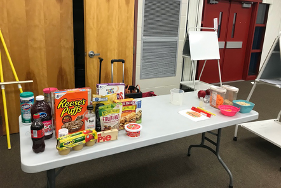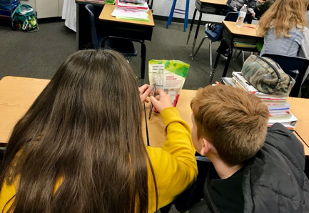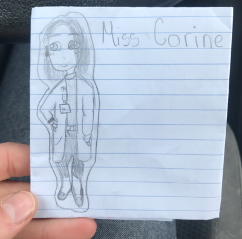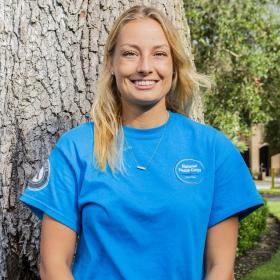Empowering Healthy Eating
 Imagine for a moment that you are a 6th-grade student walking into second period. You were told you’d have a guest speaker today, and that of course is annoying because it means you can’t go outside for PE. You walk into the gym and there are boxes of your favorite foods lined up on a table; okay things could be looking up. There are Reese’s Puffs, Lay’s Chips, Chewy Granola bars, Coca-Cola, and last but not least a monster energy drink - the ultimate forbidden fruit. As you crowd the table full of food to participate in what must be none other than a magnificent surprise taste test, you’re instead instructed to sit down and complete a “pre-test” on basic nutrition principles. Oh, and there is no actual food - it turns out the boxes are completely empty. You, the hungry 12-year-old counting down class periods until lunch, are not very happy with me.
Imagine for a moment that you are a 6th-grade student walking into second period. You were told you’d have a guest speaker today, and that of course is annoying because it means you can’t go outside for PE. You walk into the gym and there are boxes of your favorite foods lined up on a table; okay things could be looking up. There are Reese’s Puffs, Lay’s Chips, Chewy Granola bars, Coca-Cola, and last but not least a monster energy drink - the ultimate forbidden fruit. As you crowd the table full of food to participate in what must be none other than a magnificent surprise taste test, you’re instead instructed to sit down and complete a “pre-test” on basic nutrition principles. Oh, and there is no actual food - it turns out the boxes are completely empty. You, the hungry 12-year-old counting down class periods until lunch, are not very happy with me.
When I learned that a large portion of my position as a Health Educator at The PLAYERS Center for Child Health would involve convincing 6th grade students about the importance of nutrition - in a 45-minute class - I knew I’d have my work cut out for me. I laughed at the prospect of creating a curriculum that would compel a sugar-crazed middle school student to choose the healthier option when I myself still struggle with this. After many revisions to my curriculum, I eventually came to terms with the fact that students would not possibly be able to retain all the information I relayed to them about calories, sugar, and food groups. They would not be able to directly go out and purchase the healthy fruits and vegetables I talked about or change the contents of their pantry. I was feeling discouraged by the limitations that existed because I understood how the eating habits kids develop now would shape their health behaviors for years to come.
What I eventually came to realize however was that the best way for me to educate students about nutrition and healthy eating was not by telling them what they should or shouldn't eat. Nor was it by scaring them with the reality of heart disease or diabetes. I couldn’t make their schools offer more servings of vegetables at lunch, or convince their parents to stop buying juice and soda. The best way for me to truly leave an impact on my students was to instead empower them to want to take this health journey on their own. I wanted them to leave my class with the motivation to be a healthier version of themselves, for themselves.
After their initial disappointment passed and they realized I had no samples for them to consume, the students actually began to tune in to what I had to say. I was able to demonstrate how the items on the table they deemed “healthy” were designed to be deceiving. How the terms “organic”, “sugar-free”, and “natural” that were plastered on every food package had in fact very little to do with the nutritional value of the food inside it. We discussed the marketing tricks companies use to influence consumers to buy their products and we learned how to properly read a nutrition label - the one portion of the box that is legally required to contain the truth. With every class that I taught I saw the skeptics turn into believers, and I watched as their curiosity grew. The students were genuinely invested in  the information that I had to share, and not because they were afraid of heart disease or diabetes. They cared because this was not a new rule or guideline for them to follow, but instead a new opportunity to be independent. 6th grade is an interesting time for kids. This is an age where they are beginning to think on their own and manage their own decisions. I wanted the students to realize that their health was a lifelong journey and they are in the driver’s seat, and this seemed to really resonate with them.
the information that I had to share, and not because they were afraid of heart disease or diabetes. They cared because this was not a new rule or guideline for them to follow, but instead a new opportunity to be independent. 6th grade is an interesting time for kids. This is an age where they are beginning to think on their own and manage their own decisions. I wanted the students to realize that their health was a lifelong journey and they are in the driver’s seat, and this seemed to really resonate with them.
By teaching my students how to read a label, choose the healthier alternative, and outsmart the sneaky food industry, I hoped I was not only educating them, but also providing them with a lifelong ability to be their own advocate. By teaching them the transferable skills needed to make healthy choices I was putting the power back into their hands, and they were gladly accepting it. I prioritized the way I communicated with students rather than the specifics of what I was communicating, for I wanted them to feel encouraged to learn more about nutrition and their personal health beyond the classroom. The responses that I received were both rewarding and encouraging. I believe the kids felt a new sense of responsibility for their health, and were excited to take the wheel.

This post was authored by NHC Florida member Corinne Bogan.
Corrine serves at the The PLAYERS Center for Child Health at Wolfson Children’s Hospital as a Health Educator.